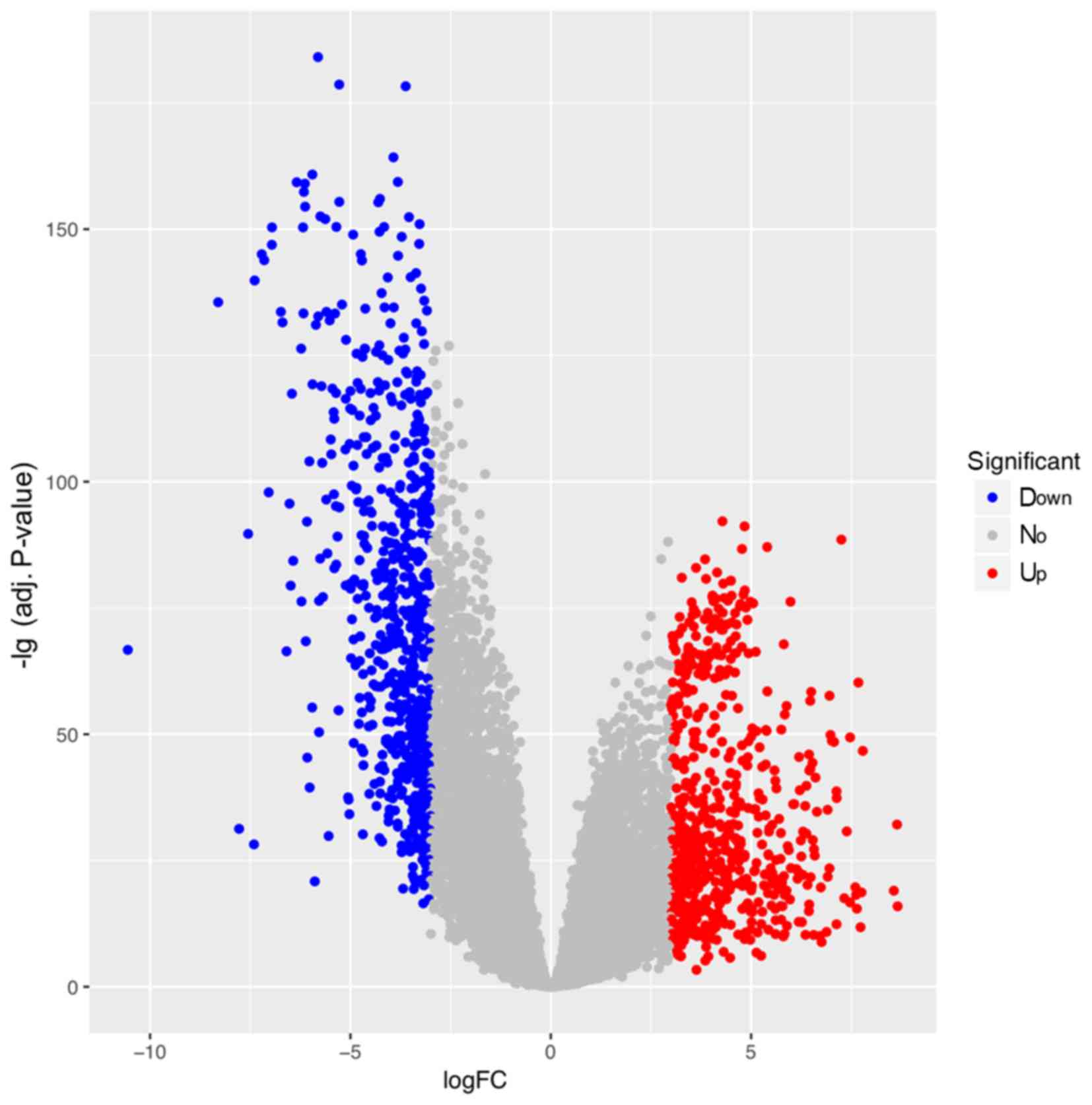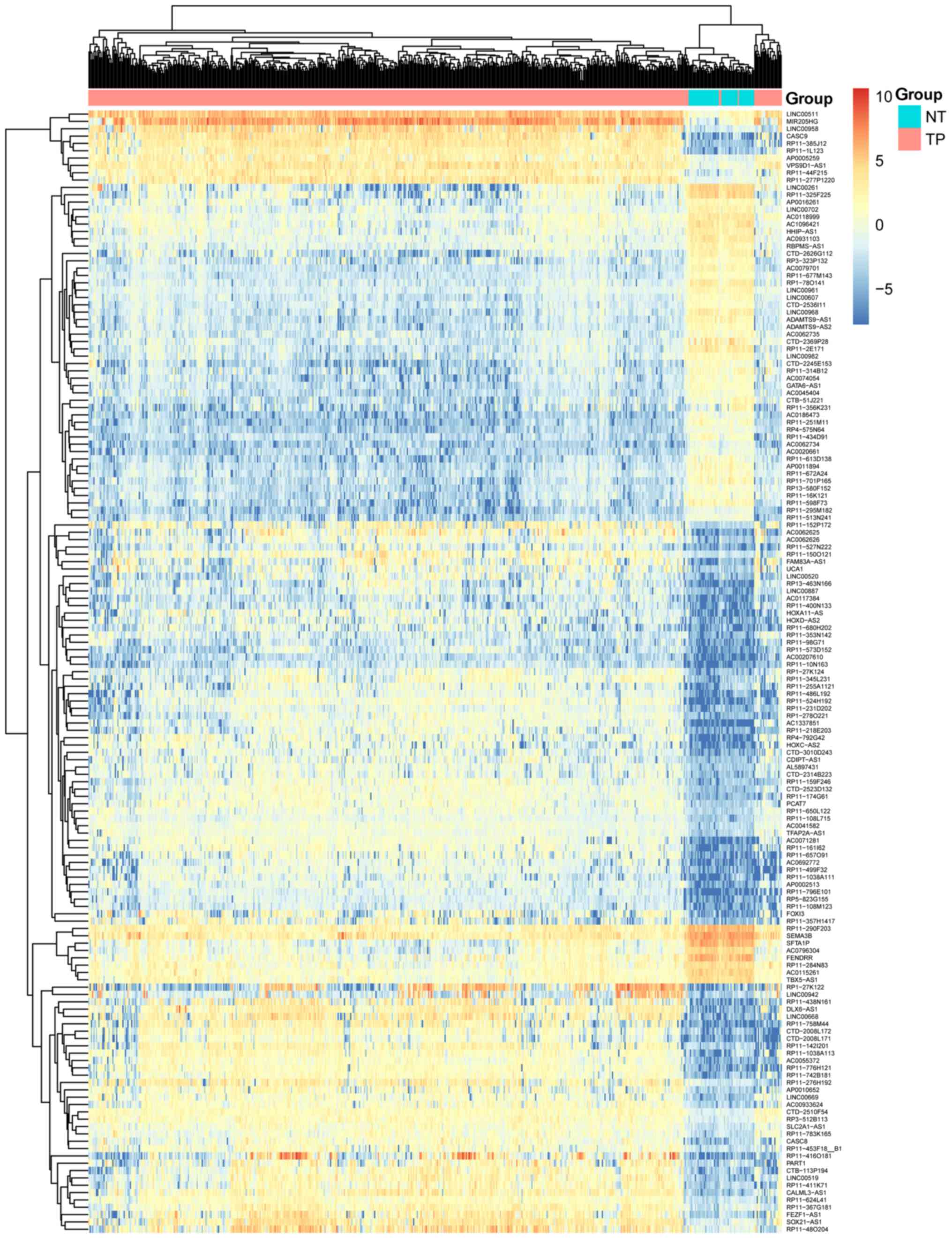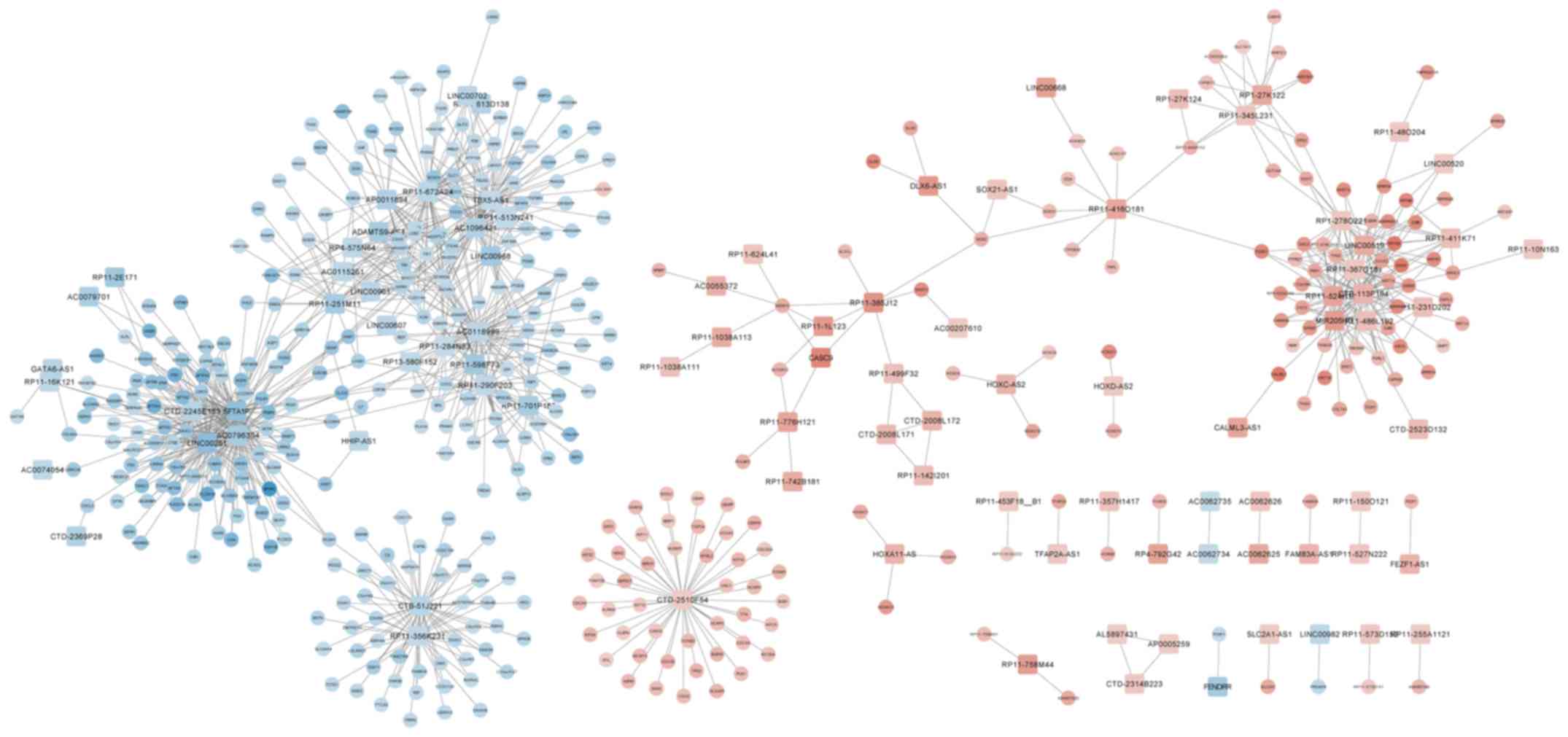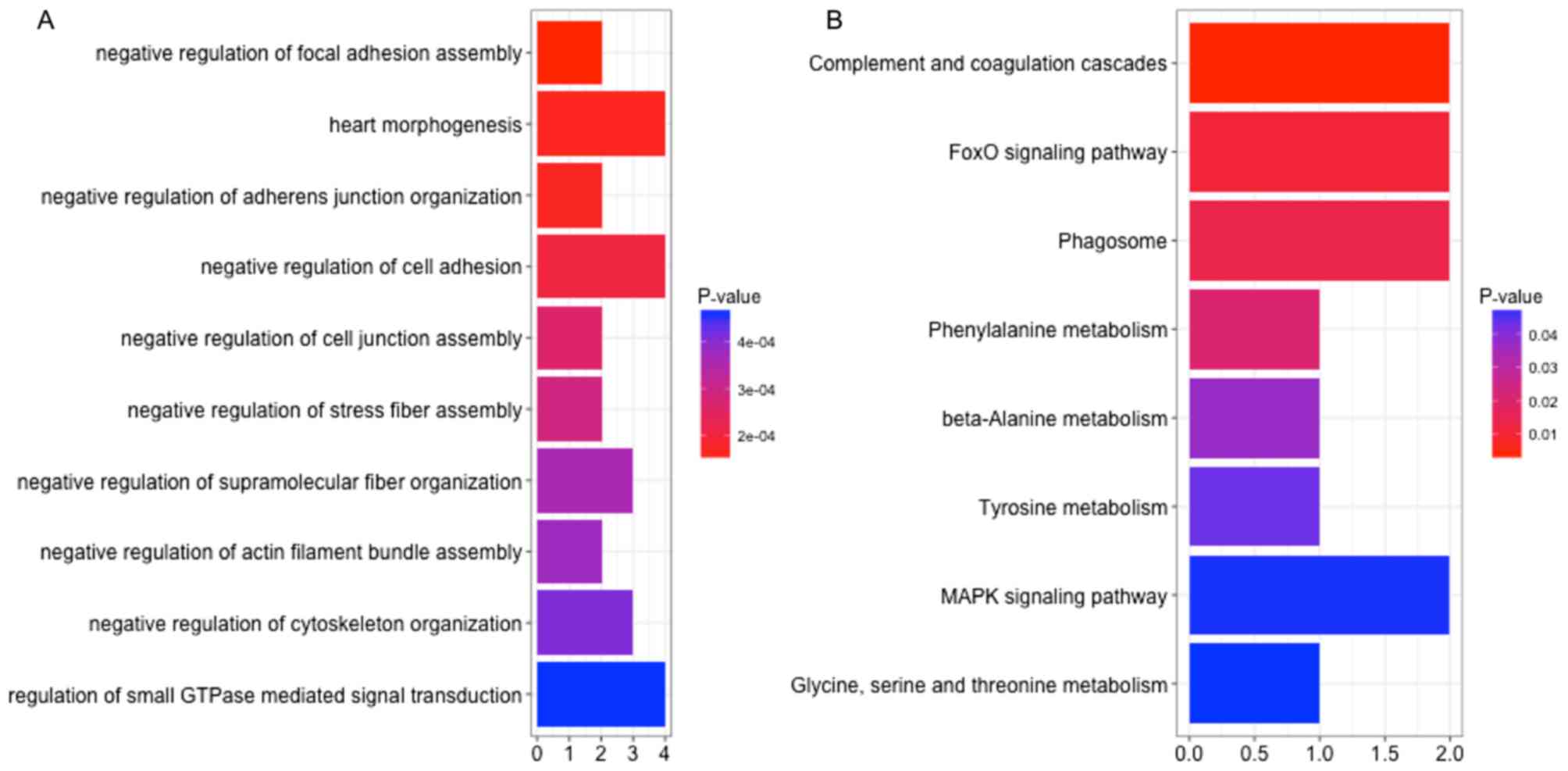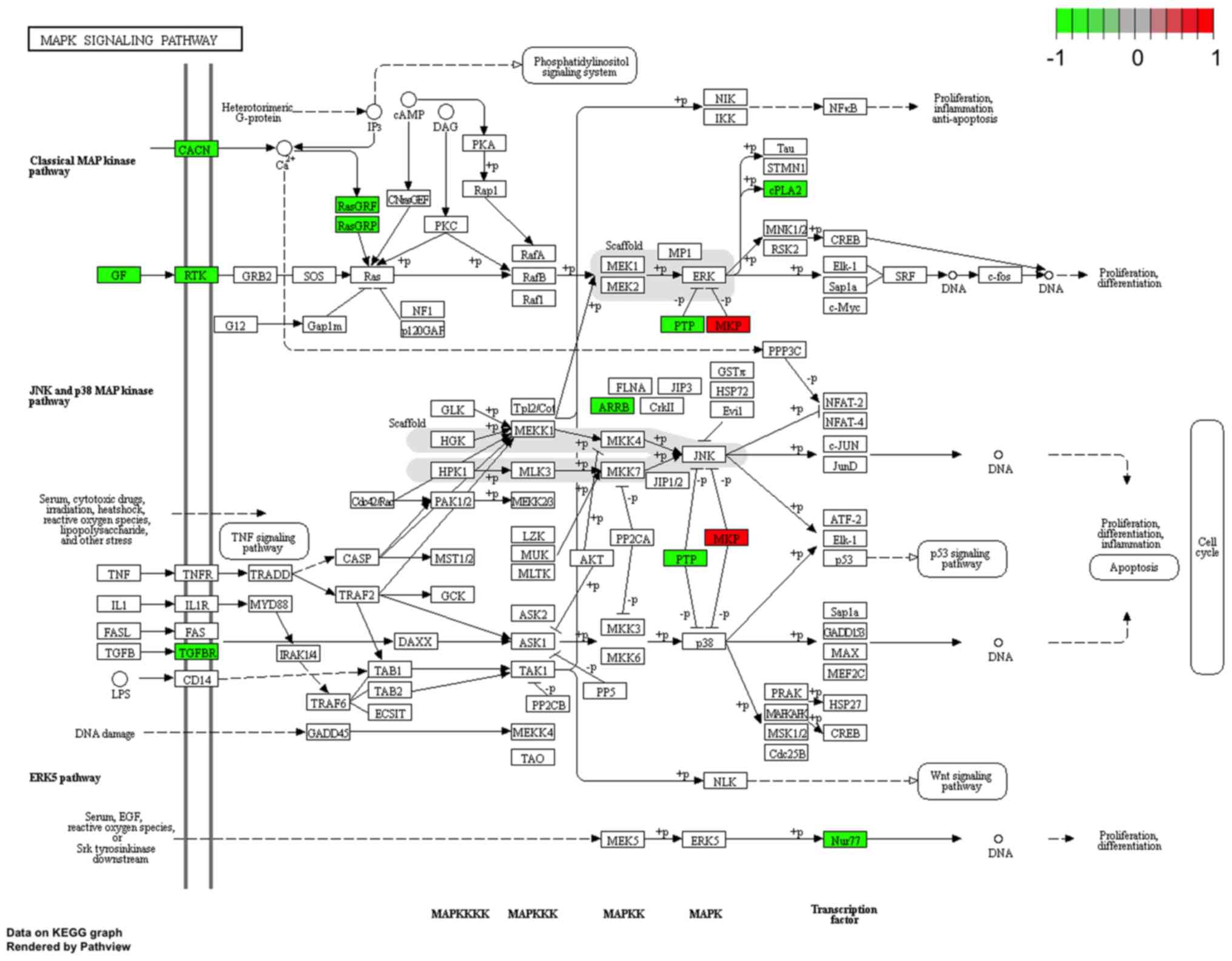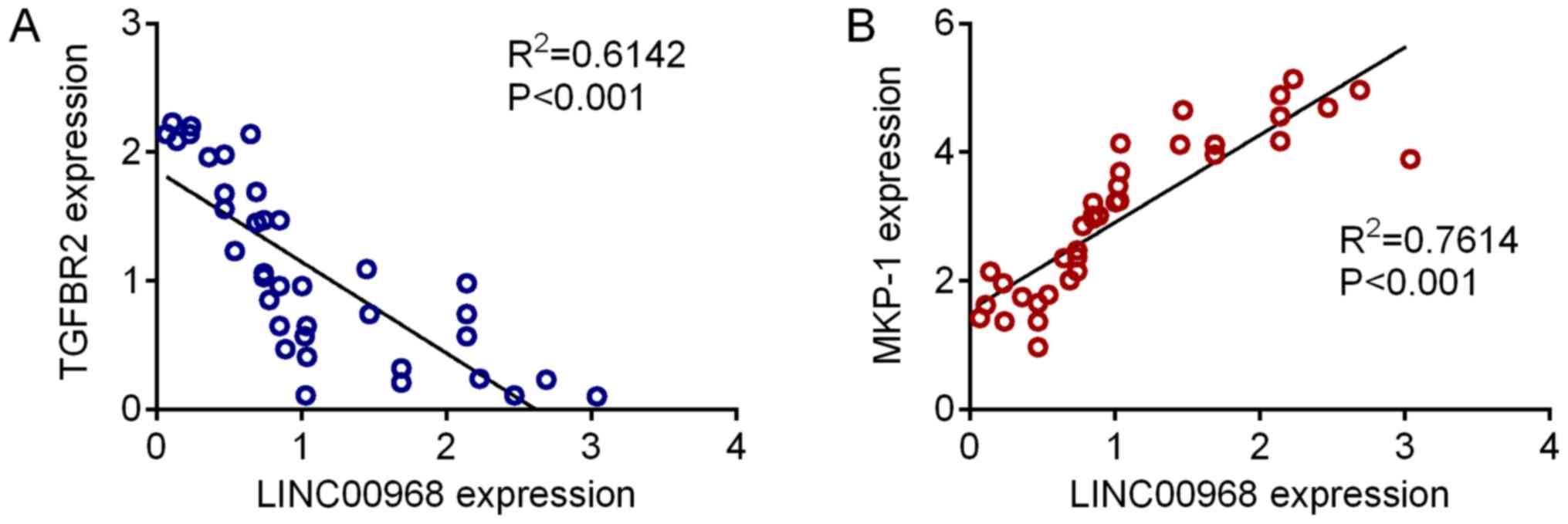Introduction
Lung cancer is classified as small-cell lung
carcinoma (SCLC) or non-small-cell lung carcinoma (NSCLC) (1). Patients with lung cancer are frequently
effected by weight loss, shortness of breath, coughing and chest
pains (2). Lung cancer has a high
rate of incidence and mortality; in 2012, 1.8 million people were
effected, resulting in 1.6 million deaths globally (3). NSCLC accounts for ~85 % of all lung
cancer cases, and is less sensitive to chemotherapy than SCLC
(4,5). As a type of NSCLC, lung squamous cell
carcinoma (LUSC) has a higher incidence in males compared with
females, and is closely associated with a history of smoking
(6). It was therefore necessary to
investigate the pathogenesis of LUSC in order to improve the
clinical outcomes of patients, and approaches to treatment.
Long non-coding RNAs (lncRNAs) are non-coding RNAs
longer than 200 nucleotides, which serve roles in various
biological phenomena, including tumorigenesis and cancer
progression (7,8). A number of lncRNAs associated with the
outcome of patients with NSCLC have been reported; downregulation
of HMlincRNA717 (also known as gastric cancer associated transcript
2) is associated with NSCLC progression, and HMlincRNA717
expression serves as an independent marker for predicting the
survival of patients with NSCLC (9).
Expression of TatD DNase domain containing 1 (TATDN1) is associated
with the increased invasion and metastatic potential of NSCLC
cells, indicating that TATDN1 may function as a promising
prognostic biomarker and therapeutic target for the disease
(10). Overexpression of SBF2
antisense RNA 1 (SBF2-AS1) is associated with lymph node
metastasis, histological grade and poor overall survival,
indicating that SBF2-AS1 is an independent prognostic marker and
promising therapeutic target for patients with NSCLC (11). Decreased expression of tubulin alpha
4b has been reported in NSCLC cell lines and tissues, where it
mediates cell proliferation and is an adverse prognostic predictor
for NSCLC (12). The Pvt1 oncogene
may be a candidate marker for the diagnosis and prognosis of
patients with NSCLC, and may accelerate NSCLC cell proliferation by
decreasing the expression of p15 and p21 (13,14).
B-cell chronic lymphocytic leukemia (CLL)/lymphoma 2 is implicated
in the favorable prognosis of patients with localized NSCLC via its
interaction with the lncRNA metastasis-associated lung
adenocarcinoma transcript 1 (15).
However, elucidation of the roles of lncRNAs associated with the
prognosis of patients with LUSC requires further investigation.
In order to determine the mechanisms of multiple
underlying diseases, gene expression profiles of human tissues are
increasingly being analyzed using bioinformatics tools (16). In the present study, RNA-sequencing
data obtained from LUSC samples was downloaded from public
databases. This was followed by differential expression analysis,
survival analysis, co-expression network analysis and enrichment
analysis to determine key lncRNAs effecting the prognosis of
patients with LUSC. This may provide a basis for prognostic
prediction and targeted therapy in LUSC.
Materials and methods
Data extraction and
pre-processing
Using the R package of The Cancer Genome Atlas
(TCGA) Biolinks package (http://www.bioconductor.org/packages/release/bioc/html/TCGAbiolinks.html)
(17), RNA-sequencing and clinical
data for LUSC were extracted from TCGA http://cancergenome.nih.gov/) database. The raw data
was pre-processed, and genes with no expression in >10% samples
were defined as those with low expression, and subsequently
filtered out. Based on the human reference genome GENCODE (hg 19)
(18), ensemble gene IDs were mapped
to gene symbols and the corresponding gene types were
characterized. The GENCODE database classified the following types
of genes as lncRNA genes: 3prime_overlapping_ncRNA, antisense_RNA,
bidirectional_promoter_lncRNA, lincRNA, macro_lncRNA, non_coding,
proessed_transcript, sense_intronic, sense_overlaping and TEC
(18). According to this typing
standard, genes from the RNA-sequencing data were grouped as lncRNA
genes, coding genes and other genes.
Differential expression analysis
Data were normalized using the R package limma
(http://www.bioconductor.org/packages/release/bioc/html/limma.html)
(19), and differential expression
analysis for LUSC and the control samples was performed. From the
genes obtained upon analysis, those with thresholds of false
discovery rate (FDR) <0.01, and |log fold change (FC)| ≥3,
differentially expressed genes (DEGs; including differentially
expressed lncRNA genes (DELs), coding genes (DECs), and other genes
(DEOs)) were selected.
Survival analysis for DELs
To analyze the prognostic features of the DELs,
samples were classified into high and low expression groups with
the median expression of DELs as the threshold. Kaplan-Meier (KM)
survival analysis (20), was
performed for clinical data to compare the survival differences
between high and low expression groups. P<0.05 was considered to
indicate a statistically significant difference.
Co-expression network and enrichment
analysis
Co-expression network analysis is a valuable method
of studying the biological functions of lncRNAs, and its
theoretical basis is that the expression profiles of genes involved
in the same biological function may be correlated (21). Pearson's correlation coefficients
were determined between the DELs and DEOs, with the correlation
coefficient |r|≥0.6 as the threshold for screening co-expression
pairs. The DEL-DEG co-expression network was constructed using
Cytoscape software v3.6.0 (http://www.cytoscape.org/) (22). Based on the results of the
co-expression network, potential functions of prognosis-associated
DELs were analyzed. Using the R package cluster Profiler
(http://bioconductor.org/packages/release/bioc/html/clusterProfiler.html)
(23), Gene Ontology (GO) terms and
Kyoto Encyclopedia of Genes and Genomes (KEGG) pathways were
predicted for those DECs co-expressed with DELs. P<0.05 was
considered to indicate a statistically significant difference.
Patient sample collection
LUSC tissues and adjacent non-tumorous tissues were
collected from 37 patients (age range, 40–80 years; mean age, 56
years; with 23 males and 14 females) with NSCLC who underwent
surgical treatment at The Second Affiliated Hospital of Nanchang
University (Nanchang, China) between May 2013 and September 2016.
Following surgical resection, tissue samples were immediately
frozen in liquid nitrogen and stored at −80°C. The study protocols
conformed to the ethical guidelines of the 1975 Declaration of
Helsinki, and were approved by the Institutional Ethical Review
Committee of The Second Affiliated Hospital of Nanchang University.
All patients enrolled in the study gave written informed
consent.
RNA extraction and reverse
transcription-quantitative polymerase chain reaction (RT-qPCR)
Total RNA was extracted from patient tissue samples
using TRIzol® (Invitrogen; Thermo Fisher Scientific,
Inc., Waltham, MA, USA) and treated with DNase I (Roche
Diagnostics, Indianapolis, IN, USA) according to the manufacturer's
protocol. RT-qPCR was performed using the TaqMan High-Capacity cDNA
Reverse Transcription Kit and the TaqMan Fast PCR Master Mix
(Applied Biosystems; Thermo Fisher Scientific, Inc.) with the
corresponding primers, according to the manufacturer's protocol.
GAPDH was used as an internal control. The RT-qPCR protocol
included an initial denaturation step (95°C for 5 min) and 40
cycles of denaturation (95°C for 10 sec), annealing (60°C for 20
sec) and extension (72°C for 10 sec). The relative expression
levels were calculated using the 2−ΔΔCq method as
previously described. The primer sequences for surfactant
associated 1, pseudogene (SFTA1P), long intergenic non-protein
coding RNA 968 (LINC00968), GATA6 antisense RNA 1, (GATA6-AS1) TBX5
antisense RNA 1 (TBX5-AS1) and FEZF1 antisense RNA 1 (FEZF1-AS1)
were as follows: SFTA1P forward, 5′-CAGGAGGTCACAGGGAAG-3′, and
reverse, 5′-AAGCCGAATACAGTTGCC-3′; LINC00968 forward,
5′-GGCAGTTTTATTGTGGTGATT-3′, and reverse,
5′-AATGGAAGTTGACGGGATAG-3′; GATA6-AS1 forward,
5′-ACGGTTTCTGGACCTTCTC-3′, and reverse, 5′-TTGTGAACTTGTGGCTCCT-3′;
TBX5-AS1 forward, 5′-GCAAAAGAAAGGGTTGGTC-3′, and reverse,
5′-AAAAGTGGGGAAACCAGAA-3′; FEZF1-AS1 forward,
5′-CTGGAGCCTTACCTGCCTT-3′, and reverse, 5′-CTGGAGGGACACACCTCAC-3′;
MKP-1 forward, 5′-GGACATTTGGGCTGTGTG-3′, and reverse,
5′-CCGCTTTTGGACTGAGAGA-3′; TGF-β receptor type-2 (TGFBR2) forward,
5′-CCCCAGGTAAGGATAGCAG-3′, and reverse, 5′-CCAGGTAGGCAGTGGAAA-3′;
and GAPDH forward, 5′-TCCTCTGACTTCAACAGCGACAC-3′, and reverse,
5′-CACCCTGTTGCTGTAGCCAAATTC-3′.
Statistical analysis
Statistical analysis was performed using GraphPad
6.0 statistical software (GraphPad Software, Inc., La Jolla, CA,
USA). Data is shown as mean ± standard deviation. Data from two
groups were analyzed using unpaired t-test and >2 groups were
analyzed using one-way analysis of variance with Tukey's post hoc
test. Spearman's correlation analysis was used to determine the
correlations between the expression levels of LINC00968 and
TGFBR2/MKP-1 in LUSC tissues. P<0.05 was considered to indicate
a statistically significant difference.
Results
Differential expression analysis
A total of 22,271 genes (including 3,685 lncRNAs,
16,045 coding genes and 2,541 other genes) from 551 samples
(including 50 LUSC and 49 control samples) were obtained. Under FDR
<0.01 and |logFC| ≥3, a total of 1,305 DEGs were identified
(including 631 upregulated, and 674 downregulated genes). Among
these DEGs, there were 153 DELs (99 upregulated and 54
downregulated), 1,109 DECs (504 upregulated and 605 downregulated)
and 43 DEOs (28 upregulated and 15 downregulated). The volcano plot
for the DEGs is displayed in Fig. 1.
The clustering heat map suggested that the identified DELs may be
used to distinguish between LUSC samples and controls (Fig. 2).
Survival analysis for identified
DELs
According to the median expression level of the
identified DELs, samples were divided into high and low expression
groups. KM survival analysis for the two groups indicated that the
expression of 22 DELs (including SFTA1P, LINC00968, GATA6-AS1,
TBX5-AS1 and FEZF1-AS1) correlated with the prognosis of patients
with LUSC (Table I). In addition,
the expression of SFTA1P, LINC00968, GATA6-AS1, TBX5-AS1 and
FEZF1-AS1 were also identified in LUSC tissues and normal tissues
using RT-qPCR. As illustrated in Fig.
3, the expression levels of SFTA1P, LINC00968, GATA6-AS1 and
TBX5-AS1 were significantly increased in LUSC tissues, and
FEZF1-AS1 expression was significantly decreased in LUSC tissues
compared with that in normal tissues (P<0.01). The KM survival
curves for SFTA1P, LINC00968, GATA6-AS1, TBX5-AS1 and FEZF1-AS1 are
displayed in Fig. 4. High
expressions of SFTA1P, LINC00968, GATA6-AS1, TBX5-AS1 predicted
poor prognosis of LUSC, while low expression of FEZF1-AS1 predicted
a poor prognosis of LUSC.
 | Figure 3.Relative expression levels of long
non-coding RNAs in tumor and adjacent, normal tissues. (A) SFTA1P,
(B) LINC00968, (C) GATA6-AS1, (D) TBX5-AS1 and (E) FEZF1-AS1 in 37
paired LUSC tumor tissues and adjacent normal tissues were
identified using reverse transcription-quantitative polymerase
chain reaction. **P<0.01, ***P<0.001. SFTA1P, surfactant
associated 1, pseudogene; LINC00968, long intergenic non-protein
coding RNA 968; GATA6-AS1, GATA6 antisense RNA 1; TBX5-AS1, TBX5
antisense RNA 1; and FEZF1-AS1, FEZF1 antisense RNA 1. |
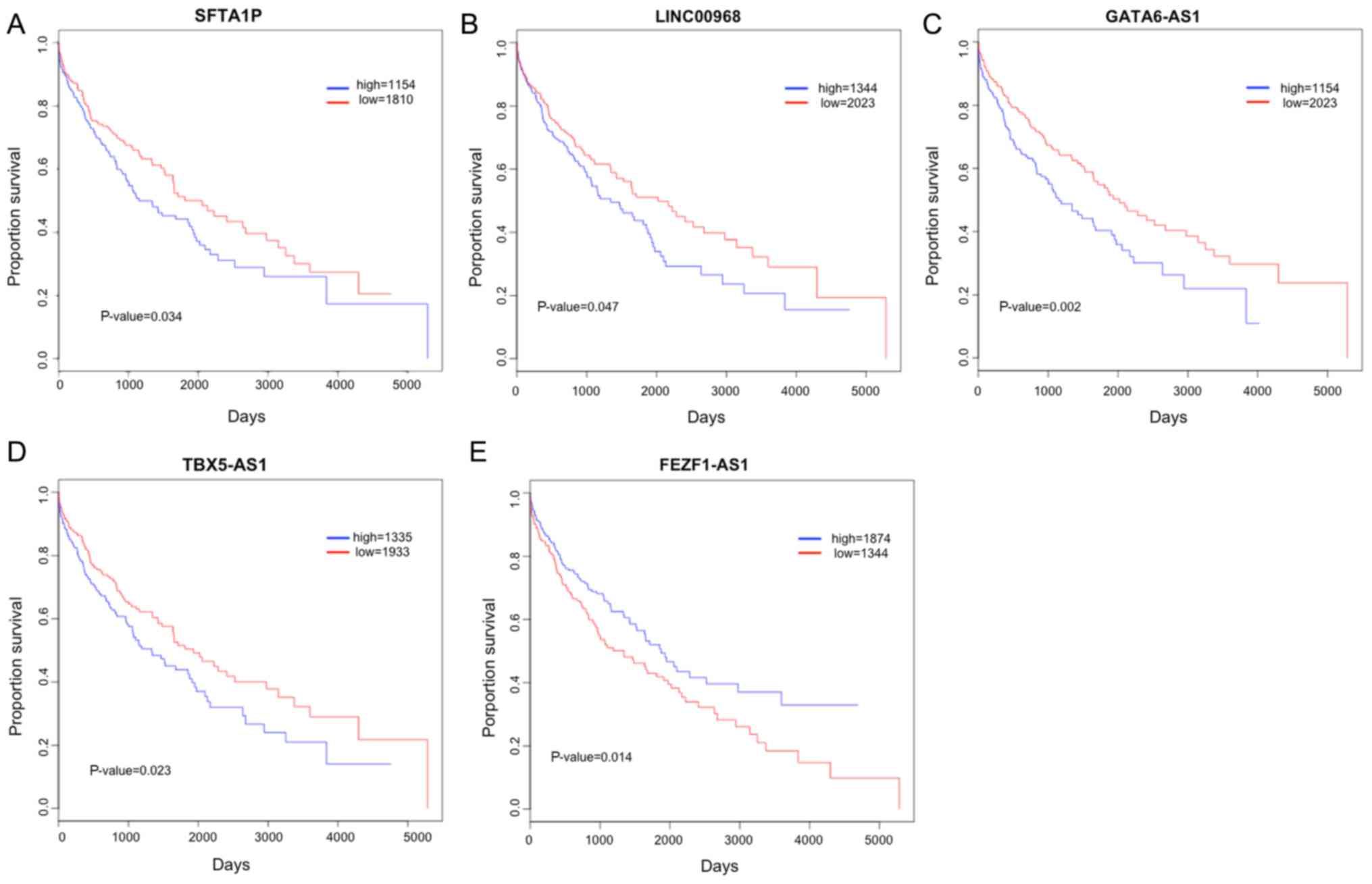 | Figure 4.Kaplan-Meier survival curves for long
non-coding RNA associations with patient survival. (A) SFTA1P, (B)
LINC00968, (C) GATA6-AS1, (D), TBX5-AS1 and (E) FEZF1-AS1. Blue and
red lines indicate high and low expression groups, respectively.
SFTA1P, surfactant associated 1, pseudogene; LINC00968, long
intergenic non-protein coding RNA 968; GATA6-AS1, GATA6 antisense
RNA 1; TBX5-AS1, TBX5 antisense RNA 1; and FEZF1-AS1, FEZF1
antisense RNA 1. |
 | Table I.Differentially expressed long
non-coding RNAs correlating with the prognosis of lung squamous
cell carcinoma. |
Table I.
Differentially expressed long
non-coding RNAs correlating with the prognosis of lung squamous
cell carcinoma.
| Gene | P-value |
|---|
| SFTA1P | 0.034 |
| LINC00968 | 0.047 |
| AC0796304 | 0.024 |
| TBX5-AS1 | 0.023 |
|
RP11-434D91 | 0.036 |
|
AC1337851 | 0.047 |
|
GATA6-AS1 | 0.002 |
|
RP11-613D138 | 0.013 |
|
RP11-385J12 | 0.032 |
|
CTD-2626G112 | 0.013 |
|
RP11-174G61 | 0.037 |
|
RP5-823G155 | 0.037 |
|
RP11-108M123 | 0.011 |
|
LINC00519 | 0.017 |
|
CTB-113P194 | 0.024 |
|
RP11-573D152 | 0.045 |
|
CDIPT-AS1 | 0.016 |
|
RP11-356K231 | 0.041 |
|
FEZF1-AS1 | 0.014 |
|
RP11-255A1121 | 0.015 |
|
RP11-357H1417 | 0.017 |
|
RP11-48O204 | 0.014 |
Co-expression network and enrichment
analysis
The construction of a DEL-DEG co-expression network
revealed 1,096 co-expressed pairs, including 93 DELs (Fig. 5). Notably, lncRNA-SFTA1P was
co-expressed with the majority of the other genes identified. A
total of 8 prognosis-associated DELs (including LINC00968, SFTA1P
and TBX5-AS1) were enriched. The GO terms and KEGG pathways
outlining the enrichment of LINC00968 are presented in Fig. 6, and details of the MAPK signaling
pathway are highlighted in Fig. 7.
The expression levels of TGFBR2 and MKP-1, which are involved in
MAPK signaling in 37 LUSC tumor samples, were identified using
RT-qPCR. Fig. 8 demonstrates that
the expression of TGFBR2 negatively correlated with that of
LINC00968 (P<0.001), whilst the expression of MKP-1 positively
correlated with LINC0096 expression (P<0.001).
Discussion
In the present study, a total of 1,305 DEGs between
LUSC samples and control samples were selected (including 153 DELs,
1,109 DECs and 43 DEOs). Survival analysis revealed that 22 DELs
(including SFTA1P, LINC00968, GATA6-AS1, TBX5-AS1 and FEZF1-AS1)
were prognosis-associated lncRNAs for LUSC. Additionally, a DEL-DEG
co-expression network involving 93 DELs was constructed. Enrichment
analysis for the DECs co-expressed with the DELs suggested that
only 8 prognosis-associated DELs (including LINC00968, SFTA1P and
TBX5-AS1) were enriched.
SFTA1P and cancer susceptibility candidate 2 mediate
the functions of tumor suppressor genes and oncogenes during the
development of LUSC, which may be used in diagnosis, prognostic
prediction and targeted therapy (24). Increased expression of SFTA1P results
in apoptosis and promotes cisplatin sensitivity in LUSC cells,
indicating that SFTA1P may be considered a promising diagnostic
marker, and an indicator for cisplatin sensitivity in patients with
LUSC (25). Downregulation of
GATA6-AS1 results in adverse outcomes for patients with gastric
cancer (26), and also serves a
tumor suppressing role in CLL (27).
GATA6 has a regulatory effect in alveolar epithelial cells
(28,29), and during lung development, GATA6-AS1
expression has been associated with that of GATA6 (30). These reports suggest that SFTA1P and
GATA6-AS1 may be implicated in the prognosis of LUSC.
TBX5 expression is significantly associated with the
disease stage, lymph node status and histopathological type of
NSCLC, and serves a tumor-suppressing role in the disease (31,32).
FEZF1-AS1 overexpression is associated with disease stage,
differentiation degree and lymph node metastasis of NSCLC, and thus
FEZF1-AS1 may promote tumor formation and be considered as a
therapeutic target for the disease (33). Furthermore, FEZF1-AS1 expression
levels were significantly upregulated in lung adenocarcinoma (LAD)
samples, which resulted in unfavorable prognosis. This suggests
that FEZF1-AS1 dysregulation promotes the development and
progression of LAD, and may therefore be used in LAD therapy
(34). The overexpression of
FEZF1-AS1 is apparent in LAD tissues and cell lines, which may
affect the cell cycle and proliferation of LAD cells by inhibiting
the expression of p57 (35).
Therefore, TBX5-AS1 and FEZF1-AS1 may also be associated with the
clinical outcome of patients with LUSC.
LINC00968 inhibition suppresses the growth, invasion
and migration of NSCLC cells, and is therefore an notable molecular
marker for the diagnosis, prognosis and treatment success of
patients with NSCLC (36). By
activating the p38 MAPK and c-Jun N-terminal kinase signaling
pathways, and suppressing the phosphatidylinositol
3-kinase/Akt/mammalian target of rapamycin signaling pathway,
treatment with platycodin-D results in autophagy in A549 and
NCI-H460 cells, and serves as an alternative compound for the
treatment of NSCLC (37). Through
the extracellular signal-regulated protein kinase/MAPK signaling
pathway, claudin-7 suppresses the migration and invasion of growth
factor-stimulated lung cancer cells (38). Pathway enrichment analysis revealed
that LINC00968 was enriched for the MAPK pathway, thus, it was
speculated that LINC00968 may affect the survival of patients with
LUSC by regulating MAPK signaling.
In conclusion, 1,305 DEGs were identified from LUSC
samples relative to corresponding control samples. The
lncRNAs-SFTA1P, LINC00968, GATA6-AS1, TBX5-AS1 and FEZF1-AS1 may be
associated with the prognosis of patients with LUSC. However, the
effects of these key lncRNAs on patient survival rate requires
further experimental verification.
Acknowledgements
Not applicable.
Funding
The present study was supported by grants from the
National Natural Science Foundation of China (grant. no. 81460010),
the Youth Science Foundation from the Science and Technology
Department of Jiangxi Province (grant. no. 20171BAB215002 and
20171BAB215040), the Medical Scientific Research Foundation of
Guangdong Province (grant. no. A2017155), the China Postdoctoral
Science Foundation funded project (grant. no. 2017M622107) and the
Postdoctoral Science Foundation of Jiangxi Province (grant. no.
2016KY51).
Availability of data and materials
The datasets used and/or analyzed during the current
study are available from the corresponding author on reasonable
request.
Authors' contributions
YX, ZL and XZ performed the literature search and
data extraction, and analyzed the data. AX analyzed the data. SX
and JL performed the literature search and data extraction. WZ and
XZ conceived and designed the study, and modified the
manuscript.
Ethics approval and consent to
participate
The present study conformed to the guidelines of the
1975 Declaration of Helsinki, and was approved by the Institutional
Ethical Review Committee of The Second Affiliated Hospital of
Nanchang University. All patients enrolled in the study gave
written informed consent.
Patient consent for publication
Not applicable.
Competing interests
The authors declare that they have no competing
interests.
References
|
1
|
Herbst RS, Heymach JV and Lippman SM: Lung
cancer. N Engl J Med. 359:1367–1380. 2008. View Article : Google Scholar : PubMed/NCBI
|
|
2
|
Cataldo JK and Brodsky JL: Lung cancer
stigma, anxiety, depression and symptom severity. Oncology.
85:33–40. 2013. View Article : Google Scholar : PubMed/NCBI
|
|
3
|
McGuire S: World cancer report 2014.
geneva, Switzerland: World health organization, international
agency for research on cancer, WHO press, 2015. Adv Nutr.
7:418–419. 2016. View Article : Google Scholar : PubMed/NCBI
|
|
4
|
Molina JR, Yang P, Cassivi SD, Schild SE
and Adjei AA: Non-small cell lung cancer: Epidemiology, risk
factors, treatment and survivorship. Mayo Clin Proc. 83:584–594.
2008. View
Article : Google Scholar : PubMed/NCBI
|
|
5
|
Reck M, Heigener DF, Mok T, Soria JC and
Rabe KF: Management of non-small-cell lung cancer: Recent
developments. Lancet. 382:709–719. 2013. View Article : Google Scholar : PubMed/NCBI
|
|
6
|
Perez-Moreno P, Brambilla E, Thomas R and
Soria JC: Squamous cell carcinoma of the lung: Molecular subtypes
and therapeutic opportunities. Clin Cancer Res. 18:2443–2451. 2012.
View Article : Google Scholar : PubMed/NCBI
|
|
7
|
Ponting CP, Oliver PL and Reik W:
Evolution and functions of long noncoding RNAs. Cell. 136:629–641.
2009. View Article : Google Scholar : PubMed/NCBI
|
|
8
|
Mercer TR, Dinger ME and Mattick JS: Long
non-coding RNAs: Insights into functions. Nat Rev Genets.
10:155–159. 2009. View
Article : Google Scholar
|
|
9
|
Xie X, Liu HT, Mei J, Ding FB, Xiao HB, Hu
FQ, Hu R and Wang MS: LncRNA HMlincRNA717 is down-regulated in
non-small cell lung cancer and associated with poor prognosis. Int
J Clin Exp Pathol. 7:8881–8886. 2014.PubMed/NCBI
|
|
10
|
Zequn N, Xuemei Z, Wei L, Zongjuan M,
Yujie Z, Yanli H, Yuping Z, Xia M, Wei W, Wenjing D, et al: The
role and potential mechanisms of LncRNA-TATDN1 on metastasis and
invasion of non-small cell lung cancer. Oncotarget. 7:18219–18228.
2016. View Article : Google Scholar : PubMed/NCBI
|
|
11
|
Zhao QS, Li L, Zhang L, Meng XW, Li LL, Ge
XF and Li ZP: Over-expression of lncRNA SBF2-AS1 is associated with
advanced tumor progression and poor prognosis in patients with
non-small cell lung cancer. Eur Rev Med Pharmacol Sci.
20:3031–3034. 2016.PubMed/NCBI
|
|
12
|
Chen J, Hu L, Wang J, Zhang F, Chen J, Xu
G, Wang Y and Pan Q: Low expression LncRNA TUBA4B is a poor
predictor of prognosis and regulates cell proliferation in
non-small cell lung cancer. Pathol Oncol Res. 23:265–270. 2017.
View Article : Google Scholar : PubMed/NCBI
|
|
13
|
Cui D, Yu CH, Liu M, Xia QQ, Zhang YF and
Jiang WL: Long non-coding RNA PVT1 as a novel biomarker for
diagnosis and prognosis of non-small cell lung cancer. Tumour Biol.
37:4127–4134. 2016. View Article : Google Scholar : PubMed/NCBI
|
|
14
|
Yang YR, Zang SZ, Zhong CL, Li YX, Zhao SS
and Feng XJ: Increased expression of the lncRNA PVT1 promotes
tumorigenesis in non-small cell lung cancer. Int J Clin Exp Pathol.
7:6929–6935. 2014.PubMed/NCBI
|
|
15
|
Schmidt LH, Görlich D, Spieker T, Rohde C,
Schuler M, Mohr M, Humberg J, Sauer T, Thoenissen NH, Huge A, et
al: Prognostic Impact of Bcl-2 depends on tumor histology and
expression of MALAT-1 lncRNA in non-small-cell lung cancer. J
Thorac Oncol. 9:1294–1304. 2014. View Article : Google Scholar : PubMed/NCBI
|
|
16
|
Servant N, Roméjon J, Gestraud P, La Rosa
P, Lucotte G, Lair S, Bernard V, Zeitouni B, Coffin F,
Jules-Clément G, et al: Bioinformatics for precision medicine in
oncology: Principles and application to the SHIVA clinical trial.
Front Genet. 5:1522014. View Article : Google Scholar : PubMed/NCBI
|
|
17
|
Colaprico A, Silva TC, Olsen C, Garofano
L, Cava C, Garolini D, Sabedot TS, Malta TM, Pagnotta SM,
Castiglioni I, et al: TCGAbiolinks: An R/Bioconductor package for
integrative analysis of TCGA data. Nucleic Acids Res. 44:e712016.
View Article : Google Scholar : PubMed/NCBI
|
|
18
|
Harrow J, Frankish A, Gonzalez JM,
Tapanari E, Diekhans M, Kokocinski F, Aken BL, Barrell D, Zadissa
A, Searle S, et al: GENCODE: The reference human genome annotation
for the ENCODE project. Genome Res. 22:1760–1774. 2012. View Article : Google Scholar : PubMed/NCBI
|
|
19
|
Smyth GK: Limma: Linear models for
microarray dataSpringer; New York: 2005, View Article : Google Scholar
|
|
20
|
Miettinen OS: Survival analysis: Up from
Kaplan-Meier-Greenwood. Eur J Epidemiol. 23:585–592. 2008.
View Article : Google Scholar : PubMed/NCBI
|
|
21
|
Cogill SB and Wang L: Co-expression
network analysis of human lncRNAs and cancer genes. Cancer Inform.
13 (Suppl 5):S49–S59. 2014.
|
|
22
|
Kohl M, Wiese S and Warscheid B:
Cytoscape: Software for visualization and analysis of biological
networks. Methods Mol Biol. 696:291–303. 2011. View Article : Google Scholar : PubMed/NCBI
|
|
23
|
Yu G, Wang LG, Han Y and He QY:
clusterProfiler: An R package for comparing biological themes among
gene clusters. OMICS. 16:284–287. 2012. View Article : Google Scholar : PubMed/NCBI
|
|
24
|
Huang GQ, Ke ZP, Hu HB and Gu B:
Co-expression network analysis of long noncoding RNAs (IncRNAs) and
cancer genes revealsSFTA1P and CASC2abnormalities in lung squamous
cell carcinoma. Cancer Biol Ther. 18:115–122. 2017. View Article : Google Scholar : PubMed/NCBI
|
|
25
|
Li L, Yin JY, He FZ, Huang MS, Zhu T, Gao
YF, Chen YX, Zhou DB, Chen X, Sun LQ, et al: Long noncoding RNA
SFTA1P promoted apoptosis and increased cisplatin chemosensitivity
via regulating the hnRNP-U-GADD45A axis in lung squamous cell
carcinoma. Oncotarget. 8:97476–97489. 2017.PubMed/NCBI
|
|
26
|
Park SM, Park SJ, Kim HJ, Kwon OH, Kang
TW, Sohn HA, Kim SK, Moo Noh S, Song KS, Jang SJ, et al: A known
expressed sequence tag, BM742401, is a potent lincRNA inhibiting
cancer metastasis. Exp Mol Med. 45:e312013. View Article : Google Scholar : PubMed/NCBI
|
|
27
|
Wang LQ, Wong KY, Li ZH and Chim CS:
Epigenetic silencing of tumor suppressor long non-coding RNA
BM742401 in chronic lymphocytic leukemia. Oncotarget.
7:82400–82410. 2016.PubMed/NCBI
|
|
28
|
Zhou B, Francis TA, Yang H, Tseng W, Zhong
Q, Frenkel B, Morrisey EE, Ann DK, Minoo P, Crandall ED and Borok
Z: GATA-6 mediates transcriptional activation of aquaporin-5
through interactions with Sp1. Am J Physiol Cell Physiol.
295:C1141–C1150. 2008. View Article : Google Scholar : PubMed/NCBI
|
|
29
|
Zhang Y, Goss AM, Cohen ED, Kadzik R,
Lepore JJ, Muthukumaraswamy K, Yang J, DeMayo FJ, Whitsett JA,
Parmacek MS and Morrisey EE: A Gata6-Wnt pathway required for
epithelial stem cell development and airway regeneration. Nat
Genet. 40:862–870. 2008. View
Article : Google Scholar : PubMed/NCBI
|
|
30
|
Herriges MJ, Swarr DT, Morley MP, Rathi
KS, Peng T, Stewart KM and Morrisey EE: Long noncoding RNAs are
spatially correlated with transcription factors and regulate lung
development. Genes Dev. 28:1363–1379. 2014. View Article : Google Scholar : PubMed/NCBI
|
|
31
|
Ma R, Yang Y, Tu Q and Hu K:
Overexpression of T-box transcription factor 5 (TBX5) inhibits
proliferation and invasion in non-small cell lung carcinoma cells.
Oncol Res. 1495–1504. 2017. View Article : Google Scholar : PubMed/NCBI
|
|
32
|
Greulich F, Rudat C and Kispert A:
Mechanisms of T-box gene function in the developing heart.
Cardiovasc Res. 91:212–222. 2011. View Article : Google Scholar : PubMed/NCBI
|
|
33
|
Ghassemi S, Vejdovszky K, Sahin E,
Ratzinger L, Schelch K, Mohr T, Peter-Vörösmarty B, Brankovic J,
Lackner A, Leopoldi A, et al: FGF5 is expressed in melanoma and
enhances malignancy in vitro and in vivo. Oncotarget.
8:87750–87762. 2017. View Article : Google Scholar : PubMed/NCBI
|
|
34
|
Liu Z, Zhao P, Han Y and Lu S: LincRNA
FEZF1-AS1 is associated with prognosis in lung adenocarcinoma and
promotes cell proliferation, migration and invasion. Onco Res.
27:39–45. 2018. View Article : Google Scholar
|
|
35
|
Jin S, Chen S, Ma Y, Yang B and Liu Y:
LincRNA FEZF1-AS1 contributes to the proliferation of LAD cells by
silencing p57 expression. Oncotarget. 8:103004–103013. 2017.
View Article : Google Scholar : PubMed/NCBI
|
|
36
|
Wang Y, Zhou J, Xu YJ and Hu HB: Long
noncoding RNA LINC00968 acts as oncogene in NSCLC by activating the
Wnt signaling pathway. J Cell Physiol. 233:3397–3406. 2018.
View Article : Google Scholar : PubMed/NCBI
|
|
37
|
Zhao R, Chen M, Jiang Z, Zhao F, Xi B,
Zhang X, Fu H and Zhou K: Platycodin-D induced autophagy in
non-small cell lung cancer cells via PI3K/Akt/mTOR and MAPK
signaling pathways. J Cancer. 6:623–631. 2015. View Article : Google Scholar : PubMed/NCBI
|
|
38
|
Lu Z, Ding L, Hong H, Hoggard J, Lu Q and
Chen YH: Claudin-7 inhibits human lung cancer cell migration and
invasion through ERK/MAPK signaling pathway. Exp Cell Res.
317:1935–1946. 2011. View Article : Google Scholar : PubMed/NCBI
|















